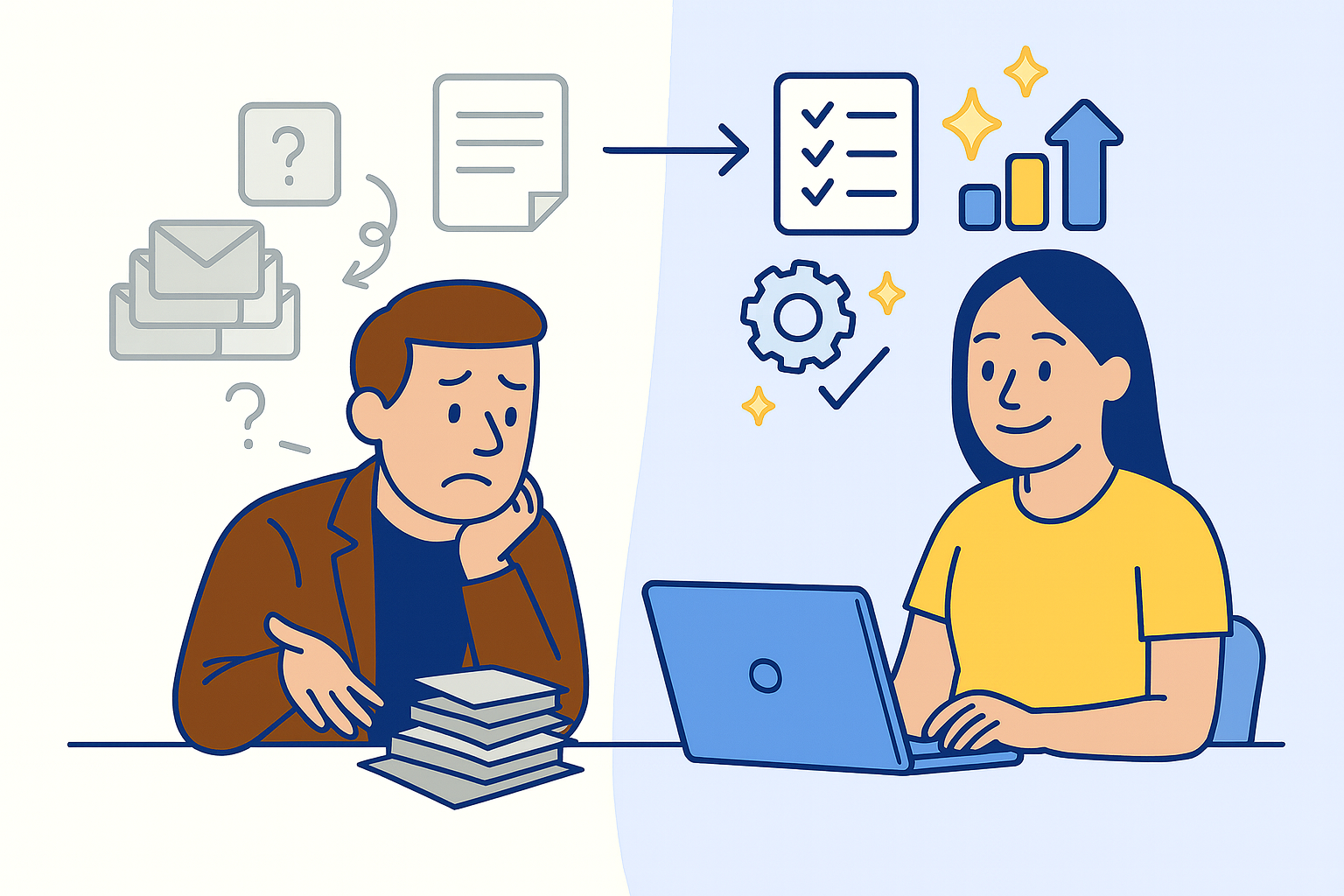Chapter 2 - The Live Chat Basics: Using it Effectively
Delve into Chapter 2 for an in-depth look at live chat basics. Master the essentials and elevate your customer service game. Learn more.
.jpg)
This is Chapter 2 of the Definitive Guide to Live Chat - you can start at the beginning of the guide here, to understand the live chat basics and how they can benefit your business.
As a company who services a variety of clients with thousands of live chats per week, we’ve learned first hand the processes that work well.
WARNING- Live Chat is one of the few marketing tools that could actually hurt your business if not done well.
A savvy ad campaign means wasted money if sales are not produced for your business, but otherwise nothing is lost.
However, if you implement Live Chat improperly, then you could actually end up hurting your business reputation through bad customer relationships. This loses not only current revenue, but future revenue as well.
Before we cover advanced tactics for Live Chat, let’s make sure you have the basics down.
Live Chat Basics: Avoid Required Pre-Chat Forms
When you enter a retail store and ask a question, does the employee require you give personal information upfront before helping you? Never!
So why would you require a visitor who has a simple question to give their name and email address?

You shouldn’t.
If a visitor clicks the “ask a question” box, the best experience for them is to simply be helped by your team without having to commit to providing any information. Many websites do make this mistake. But you shouldn’t be one of them.
Make the Live Chat Option Easy to Find
Staying with the example of a retail shopping experience, because this is what most people know, imagine that you have a question while shopping at the Apple Store. It would be unusual if you couldn’t find an employee to answer your question, wouldn’t it?
Some websites make the mistake of having Live Chat available only on certain parts of their websites. Others make the mistake of having Live Chat someplace other than the lower right corner, where visitors are accustomed to finding it.
Here’s what not to do:
- Don’t make the only option a small “live chat” button in the top of your website
- Don’t rely only on sidebar “live chat” banners to show people that you have live chat
- Both of the above are helpful, but having chat available on all pages in the bottom right hand corner is the best practice that the world has come to expect- visitors will get lost if you don’t do that at a minimum.
If visitors can’t find it right away, then they are much more likely to leave your website without asking you the question that is keeping them from buying. And you end up with a lost sale.
Don't Ignore People- Duh!
Imagine that you are in a retail store and an employee walked up to you asking,
”Do you have a question I can help with?” This is probably a good experience, at least so far.
But imagine that you ask your question, and the employee literally turns around and walks away--completely ignoring you. That’s a seriously bad experience, right?
Many businesses make this same mistake with their Live Chat systems.
- They put the Live Chat box there for visitors to use,
- But when the visitor asks a question- they get the silent treatment. No one is there to respond.
That probably sounds like something you would never want to happen, but it happens all the time with businesses that otherwise have great customer service intentions:
Here's how this could happen to you:
- You add live chat to your website.
- You stay logged in whenever you can.
- Sometimes you forget to logout when you're away from your computer or on a phone call.
- When a chat comes in, you're not easily able to respond in just a few seconds to start the conversation with the visitor.
- The visitor gets impatient, feels ignored, and leaves your site.
The Solution? You Need Someone Dedicated to Live Chat
One of the main reasons that this happens is that the person responsible for managing the Live Chat systems is also responsible for managing many other aspects of the business (answering phones, doing sales demos, etc.).
- While this might seem logical since you may not get a ton of chats at every hour of the day, it sets you up for getting into a situation where visitors aren’t replied to quickly.
- Also, as the live chat system starts to work well for your business and produce good sales leads, the person responsible for managing chat and converting leads to customers ends up in a difficult situation: they get more leads, which leads to more time closing deals, which means they’re not available to chat on the website, which means less leads come in. In short, it’s impossible to do well at both roles, but both roles are extremely important to each other.
How Fast is “Respond Fast”?
A good “first response time” for Live Chat is between 4-6 seconds. The absolute maximum is 20 seconds. In a later section, we’ll share ways that you can measure and reach these targets. For now, focus on give your visitors a great experience by not leaving awkward silences in your Live Chat box, which is one of the live chat basics.
Make Sure Visitors Are Confident You Understand the Question
Unfortunately, many people’s experiences with Live Chat include some scenario of chatting with someone overseas who represents an enormous corporation but hasn’t been adequately trained to respond appropriately to a variety of questions.
An Example of Poor Customer Service
Here's a laughably bad example from Amazon.com (Full transcript published by Business Insider):
- Someone created an Amazon account using Chris Williams' email address.
- He got a notice about this in his email account, and started a chat with Amazon to have them delete the account.
- Chris had to ask multiple times to have Farah, the Amazon Chat Agent, delete the account.
It became apparent that Farah didn't understand the question.

And once Farah finally did start to understand, she told Chris to delete his entire email account rather than help him delete the Amazon account that was created.
This obviously led to Chris being frustrated, and in this case a public example of Amazon’s poor customer service. I’m sure they’ve improved since that time, but the story lives on online because of how laughably poor the situation was handled.
Sadly, this is not an uncommon experience with Live Chat. This means that visitors who are chatting with you may be skeptical at first. Because of situations such as this one, you’ll need to earn your visitors’ trust when you chat with them.
How to Understand Complicated Questions
At first it probably seems like understanding a question would be easy. However, customers don’t always ask questions in a clear, concise manner. You’ll likely need more information to clarify the question before giving an answer.
If your Live Chat system is configured well, which we’ll discuss later, you can see the context from the visitor so you’ll have the information you need to give a good answer.
Here are the things you should be able to see while chatting with your visitor:
- What page they are viewing currently.
- What pages they have already viewed.
- What has been discussed in past Live Chats that may be relevant to the current question.
- What, if anything, they have ordered from us in the past. If they have submitted support tickets to us in the past. If so, what the details of those transactions have been.

(Image / Data Source: https://www.livechatinc.com/tour/)
All of this information should give you the context you need to understand the question the visitor is asking. And if it does not, then there’s a simple solution- ask for clarification.
Although simply asking for clarification might sound silly, you’ll find that visitors appreciate it when you do. They want you to give you the information you need to get them the answer they need. It’s a win-win. As long as your clarifying question is reasonable, of course.
Here’s an example of a clarifying question scenario:
Imagine you run the scooter company mentioned previously. A visitor sends you a Live Chat question:
Visitor: How much does this battery cost?
You can see from your side that the visitor is looking at two batteries for a certain model scooter.
You reply: Model A59 costs $179 and Model B59 costs $199. Do you have questions about which model will work for your scooter? If you tell me which scooter you have I can help you determine what you need.
Visitor: I have the red scooter.
You reply: Okay, there should be a model number on the silver plate on the back that will help me get you the right battery,
Visitor, after a pause: It’s XZ404.
You reply: Okay, great. Then the battery you need is A59. That one costs $179 and we have free shipping. What other questions can I help you with?
Visitor: That’s all. Thanks.
You reply: You’re welcome. Have a good day.
Once you correctly understand the question the visitor is asking, you can supply the answer. Your visitor will feel more confident and you’ll be one step closer to making a sale.
Turn Chats into Leads and Sales
Live Chat allows you to truly help your visitors by being available any time, responding quickly, and giving good answers to questions. The mindset of customer service should always come first, but you can also use the opportunity of Live Chats to get the leads and sales, which are part of the live chat basics.
Look for Opportunity Indicators
If you are a seller of shipping supplies and products to businesses, then you know a business that ships 100 units per day is ultimately going to be more valuable to you than a small business that ships only 2 units per week.
Live Chat provides an excellent opportunity to engage with a future customer and gain information without being too “salesy”. You can learn a great deal about a prospect simply by listening to the questions that they ask and the details they are willing to share with you during the conversation.
Learning to ask specific questions in a strategic way allows your team to gain information that will be helpful to future relationships with this client.
Here’s an Example
Visitor: I’m looking for a supplier for cardboard boxes. I see they are 6.92 ea. Is there a price break at any
quantities?
As the first question the visitor asks, this offers two big hints that this is a potential buyer of large quantities of these types of products.
- The most obvious: "Is there a price break at any quantities?". This indicates that the visitor has plans to order more than just a few items.
- The word “supplier” indicates that this visitor is looking for more than simply a one-time purchase. They need someone from whom they can make frequent purchases.
Of course, this example is fairly specific since the visitor basically handed the information to you. Sometimes you may have to work a little harder to get the information you need, but the idea is to always be learning about the visitor’s potential as a customer for your business.
Here’s an example of a more subtle exchange:
We run the live chat system for a website that sells payment systems and equipment for brick and mortar retailers. We frequently get chats with basic questions about terminals, but sometimes a visitor will ask more complicated questions such as:
- Can this payment terminal integrate with (industry leading/premium priced retail inventory system)?
- How long is the installation process to change from a previous system?
- What equipment is needed at each store location to sync with headquarters’ reporting system?
You know that these questions would only be asked by a serious prospect because they are so detailed.
The kind of visitor who would ask these types of questions usually fits the below profile:
- Already using (or considering a purchase) the industry leading/premium priced retail inventory system. This shows that they’re serious about creating the best infrastructure for their business.
- Already invested in infrastructure in the past. This means they already have an established business, and they are more likely to move quickly to change systems.
- A company that needs to supply multiple locations with products, which means this is a lead for multiple sales.
The moral of the story is that it is vital to read between the lines when people ask complicated questions. Not only should you be seeking to give them answers, but you should also be looking to determine the amount of potential this visitor has to turn into a big sales lead, which is a fundamental aspect of live chat basics.
Build Interest & Trust While Gaining Insight
When a visitor asks a question, you can learn a great deal about them and their business. If they don’t readily share this information, you should try to seek it out in a professional way whenever possible.
Keep the conversation going by engaging the visitor’s interest. Otherwise the visitor will simply become annoyed. Here are some simple, but effective, ways to keep visitors engaged in Live Chat:
- When answering questions, ask for a few more details that might impact the answer. For example, if a customer asks about how long shipping takes, give the standard answer but also ask leading questions such as “When do you need it to arrive? We might be able to find a better shipping option.” This desire to go above and beyond will build rapport with the visitor and keeps them engaged. This can also give you insight into their specific business needs.
- Share additional resources when answering questions. For instance, if a visitors asks what brand of mobile payment terminals you recommend, give them your specific brand recommendation, but also link them to a brand comparison post from your blog. This will keep them engaged while giving them more context.
- As you keep the conversation going, ask strategic questions which give you information about potential sales opportunities. For example, if a visitor asks if the payment terminal syncs in real-time with headquarters reporting system, you can ask how many locations they’ll need before providing the answer. This will give you context regarding the size of the business while answering their question.
Close the Sale - Get the Purchase or Lead
Helping visitors is the main priority of Live Chat, but there are a few steps you can take to turn as many chats as possible into revenue for your business.
The Hard Close
If you have answered a question for a visitor through Live Chat and it seems like they are ready to make a purchase, offer to help them through the process. This allows you to ensure they get through the process successfully and complete the purchase right away.
But how can you tell if a visitor is ready to make a purchase? Typically you can tell by the questions they ask or by seeing the pages they’re on.
Here’s some obvious signs to look for:
- They ask about shipping times. This indicates they are trying to find out when they’ll get the product- they’ve already decided that they want it.
- They’ve already placed the item in their shopping cart. This means they are likely to purchase today if you can help them through the final steps of the process.
At this stage, however it is important to be careful not to push the person too hard. In a retail store you can read a person’s body language or if they are walking toward the cash register. In a Live Chat, you need to read between the lines of what they’re saying and doing on your website.
The Follow-up Close
A common scenario is that visitors will ask questions about a product via Live Chat and then return later to make the purchase. The fact that you helped them with their questions allows them to feel trust has been built, meaning they are more likely to return to make the purchase. But it’s still not a guarantee.
If it seems like a visitor might be ready to make a purchase but is pausing, do your best to get their contact information.
- Don’t just ask for it, but offer something valuable in return. Maybe offer to email some more detailed specifications, recommendations related to product choices, or other expanded information related to their original question.
- That way, even if it doesn’t turn into a sale today, it at least converts to a sales lead, allowing you to follow up and eventually finish the sale.
We track revenue produced for the websites we manage chat for, whether the sale happens during a chat or in the hours or days after a chat. We’ve found that a simple but effective follow up process from our customers (i.e. the websites we manage chat for) significantly improves the likelihood of converting chats into future sales.
Want To Discover How
Live Chat Works?
Book a Strategy Call with our Team And Discover How HelpFlow Users Increase Their Website Conversion Rates 10%-30% or More...
Related posts












